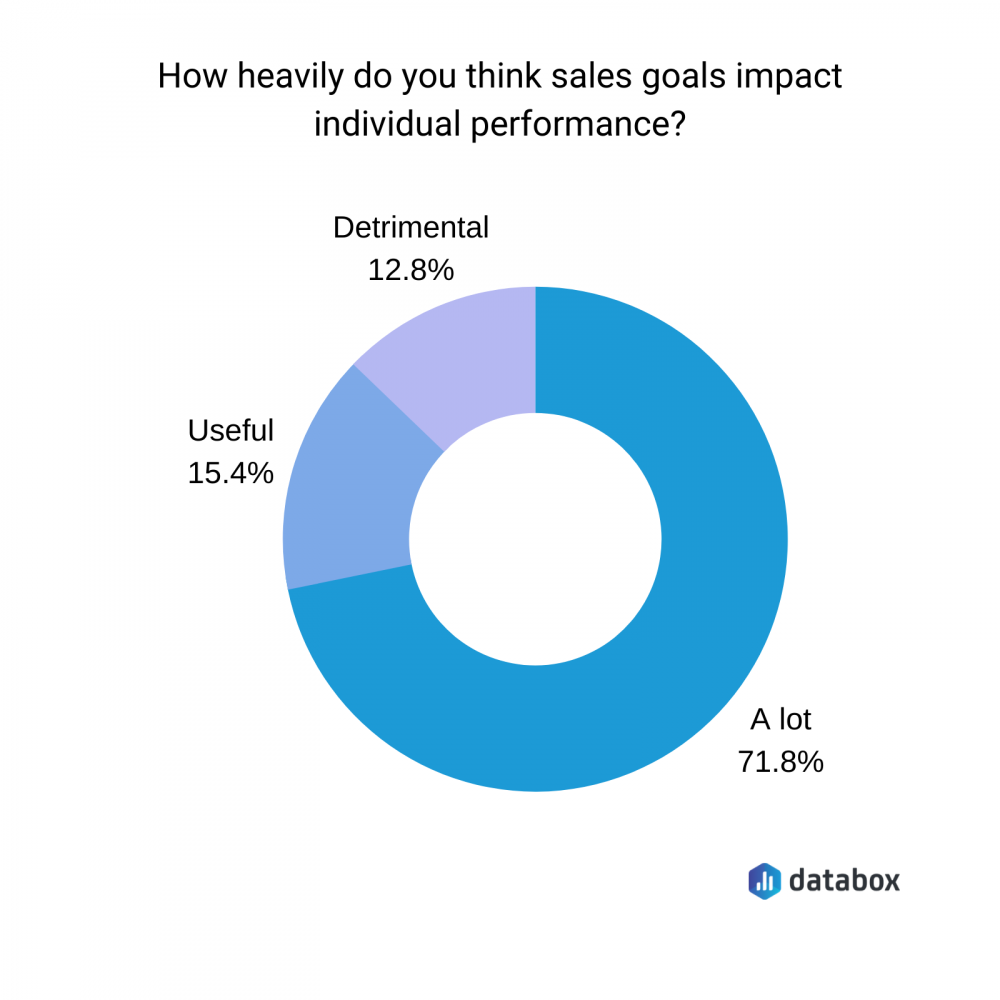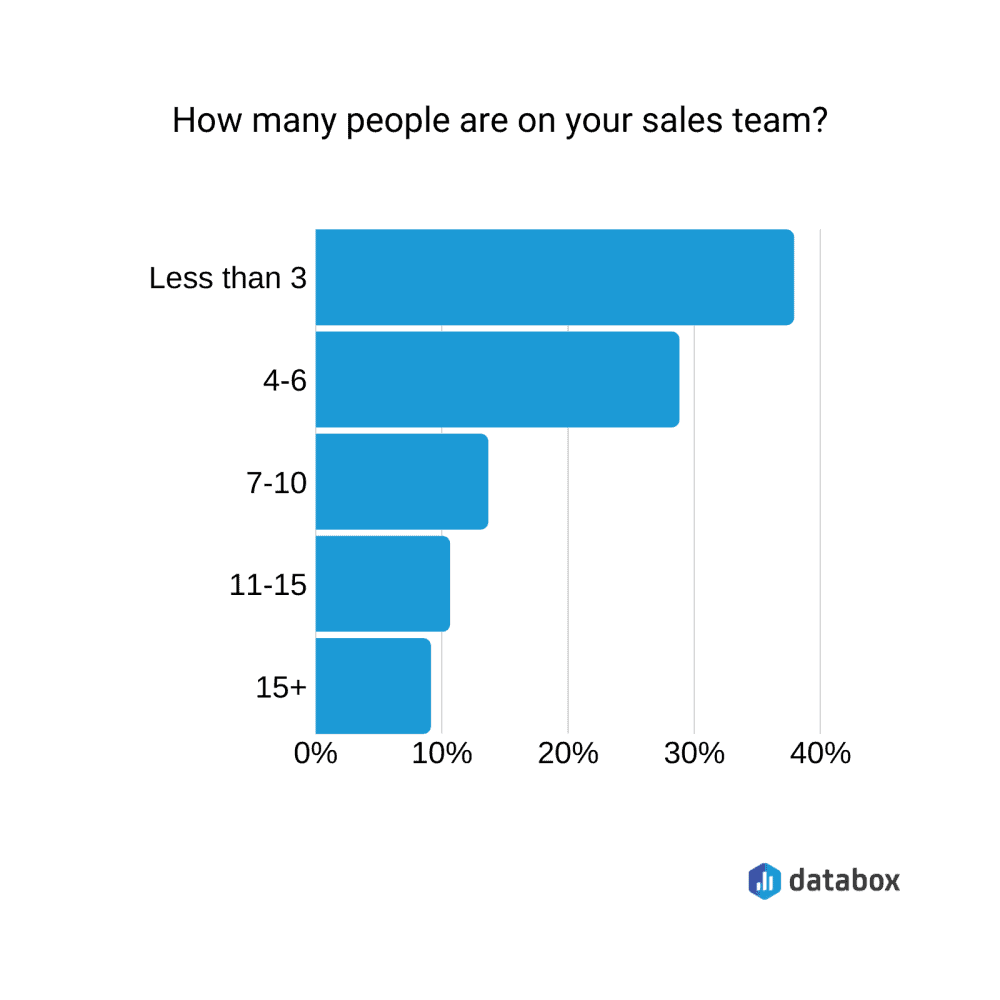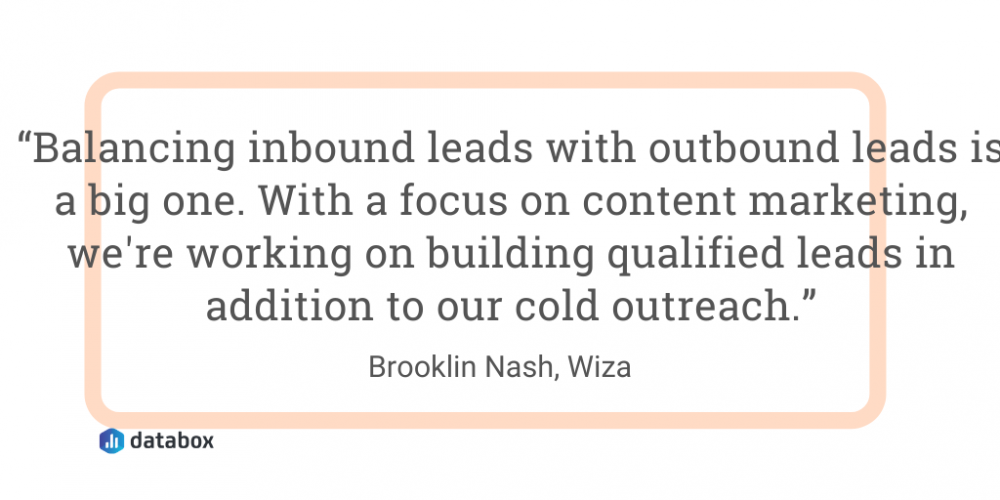Table of contents
Here’s the thing: having the right goals is crucial for any team’s success — not just a sales team.
Without a measurable outcome in mind, your team might as well be throwing darts in the dark. As team leads though, it’s your responsibility to help your teams set and achieve goals based on one or more salient metrics.
The question now is: which of the metrics are the most beneficial for creating solid, actionable goals? To answer that, we surveyed over 35 experts to learn their tips and advice on setting a sales goal. This post covers what they had to say.
To begin with, all our respondents agree that setting sales goals is extremely important — to the point that they determine your team’s performance:

Our respondents also shared some great ideas and rationales, which we broke down into a few key areas to explore. These include:
- Activity
- Conversions
- Sales & Revenue
- Persona Fit
- Process Optimization
- Leads & Prospects
- Retention & Referral
- Website and Traffic
Let’s dive into the details:
1. Activity
One of the biggest factors in sales success is sustained action and adherence to one or more activity-based metrics. This is the case for many of our experts, who hinge goals not on results, but on the actions that produce them.
Melanie Hartmann of Creo Home Buyers among others focuses on “the number of contacts with potential clients that our team makes.”
Andrew Jezic of Law Offices of Jezic and Moyse agrees: “One important sales goal we set at our firm is the number of people we have contacted each month. We are extremely understanding when it comes to conversions because bad sales days happen.”
However, Jezic shares, “if you aren’t contacting enough people, you are putting yourself at a disadvantage. I believe sales goals somewhat have an impact on individual performance, but you can increase the drive of your sales team by providing incentives for hitting their sales quota.”
And keeping those goals consistent and achievable is important. “I believe stretch goals are detrimental to a team because a goal should be challenging but attainable. Chasing goals that are wildly overshooting realistic sales numbers can be a huge hit to your team’s confidence.”
Rhy John of GR Digital Ltd also tracks contacts for the team, in the form of proposals.
“I think the biggest metric any B2B sales team should be tracking using a sales dashboard software is proposals shipped. The reasoning behind this is simple, it clarifies if your core sales pitch is catching bites and will help you narrow down your USPs to get your target customers interested and on the hook. If your proposal rate is low, then it lets you know that your pitch or offering needs work.”
It’s also about the daily maintenance efforts, adds Spencer Smith of IRC Sales Solutions. “The most important sales goal I set for my teams is for each rep to complete their follow up tasks, every single day. Depending on what type of business you’re in, it’s incredibly rare to sell something on the first call. That means that your team’s revenue, profit, commission- it all lives and dies by follow up calls.”
Related: 36 Practical Tips for Writing A Great Sales Follow Up Email
Smith continues, “After my sales reps get off of calls, they set a follow-up task in the CRM that will pop up at the selected date & time and remind the sales rep to follow up with the prospect.
Their goal is to, on a daily basis, never leave the office without completing all of those follow-up tasks. This tightens up the sales funnel significantly and we lose a LOT less prospects to the abyss of phone tag and procrastinating (or forgetting) to call prospects back.”
To make this process more consistent, Ollie Smith of CardAccounts carves out time to do the work— and rewards the effort.
“As quality leads are vital to making sales, I run a ‘leads hour’ which everyone participates in on a daily basis. This goal is to increase the number of high-quality leads generated. I incentivize my team by offering daily winners the opportunity to finish up at 3pm on any Friday of their choosing. In my experience, it has always worked well!”

Following up after the sale is important to Paige Arnof-Fenn of Mavens & Moguls. “Send three thank you notes each week to a current or prospective client or partner for something big or small. Show genuine appreciation with no strings attached and create a culture of gratitude. I want to see if it opens doors and starts conversations generating positive word of mouth.”
Sometimes, the activity goal is about internal behaviors rather than outreach. Melanie Musson of 360QuoteLLC uses a metric close to her writing team’s prime objective: putting out content.
“Monthly content word goal. It’s an easy goal to track and one that every writer can strive for even when they’re out of the loop on most of the sales goals.”
“If sales leaders had to focus on a single KPI, it should be pipeline velocity,” says Dan Liska, Director of Sales at AutoVerify. “Pipeline Velocity takes into account the way a sales team prospects (active opportunities), demos (average sales size), moves the deal through the stages (sales cycle) and closes.” It’s also very useful for forecasting as pipeline velocity can be multiplied by the number of selling days in a month.”
Liska adds, “Pipeline velocity can be calculated using the following equation: (ASP$ * AOs# * WR%) / SC# where
ASP$ is average sales price in $
AOs# is # of active opportunities
WR% is win rate % also know as close rate %
SC# is sales cycle, in days
“It takes into account how a sales team prospects (active opportunities), demos (average sales size), move the deal through the stages (sales cycle), and closes. That pipeline velocity can be used to measure the effectiveness of the team, as well as accurately forecast revenue.”
Additionally, you can use this business development dashboard to visually monitor your deal flow and progress towards set sales goals.
PRO TIP: How to Keep Track of Your Sales Team’s Performance
Sales happen every day, and if you have an active sales team, they’re busy setting up appointments, making calls, creating and nurturing deals, and closing them to generate new revenue. It’s your job to monitor their performance and work with your team to improve it. To do that, you need up-to-the-minute information at your fingertips, including:
- What’s our average deal size?
- How many open, closed, and lost deals have we seen this month?
- How much revenue can we expect to close from new deals created?
- What’s our current progress towards our sales goals?
Now you can benefit from the experience of our sales experts, who have put together a great Databox template showing all the most important KPIs for your sales team’s performance. It’s simple to implement and start using as a standalone dashboard or in sales reports!
You can easily set it up in just a few clicks – no coding required.
To set up this Sales Manager KPIs Dashboard, follow these 3 simple steps:
Step 1: Get the template
Step 2: Connect your HubSpot account with Databox.
Step 3: Watch your dashboard populate in seconds.
2. Conversions
Undoubtedly, getting people through the pipeline is important to long-term success and goal completion. No wonder, many of our experts focus their attention here.
Toni JV of JVT Media says of conversion tracking, “Conversion rate tells us a lot of things that could be going wrong. For example, we could be targeting the wrong people, or our sales process needs some work.
In either case, when we work on improving conversion rates, we naturally also start to gravitate to things that are better for your potential clients. You start to focus on adding more value and going above and beyond for your clients, and most importantly, the RIGHT clients.”
Sam Olmsted of Pelicoin Bitcoin ATM suggests that depending on the industry, the conversion can be a discrete event. “For most companies, a sales goal is based on leads, conversions, or at least conversations from customers. For us at Pelicoin, one of our most important sales goals is how many ‘Requests for Directions’ can you generate for each location.”
Olmsted goes on, “what may not seem like a sales goal at first is really the most critical part of our sales funnel.
As a cryptocurrency ATM network, our sales can’t be done online or over the phone, so they have to take place at the physical locations in which our ATMs are housed.
That being said, we view sales goals in a more holistic way and think of a direction request on Google as the first step of that process. Of course, transactions are the end-goal, but if we can get people to look up the nearest Bitcoin ATM, we know that our funnel is working correctly.”
What’s more, Shannon Trimble of Lightning Virtual Solutions tracks the conversion of leads into qualified prospects. “one of my clients tracks weekly ’15 minute calls’ as they are the introductory step into our sales funnel. We look into both the source of the individuals who book in for calls, and then how successful these calls are at progressing potential clients to the next step.” This data can be accessed using a call tracking dashboard.
One expert looks at conversion from the other end of the equation, seeing the customer’s adoption and lifestyle change as a sort of personal conversion event. Daniel O’Sullivan of Kinzoo says, “our sales goal is to encourage a new way for parents to proactively protect their kids’ privacy online. This means adopting a new mindset: a lot of apps and services collect personal information in exchange for free access, so you’re essentially paying with your data.”
With Kinzoo, we’re asking parents to think differently and consider paying money for an app that was built from the ground up to ensure their kids’ privacy. If the business model is successful, the goal will have been achieved.”
3. Sales & Revenue
Bottom-line thinking is ever popular as a sales goal, so its popularity within our survey makes sense.
These goals can be individual, as is the case with Andrea Loubier of Mailbird who says, “One important sales goal that I would highly recommend is monthly goals for each member of the sales team on an individual basis. Of course, everyone should continue to pull together to reach goals as a whole, but providing each sale team member with a sense of responsibility always leads to higher sales.”
Key takeaway? Set goals that motivate your team — no matter its size. For the record, most of our respondents have few than 3 people on their sales team.

Anosha Imran of TradeWheel.com also employs monthly sales goals. “As a general rule of thumb, we have set monthly sales goals by taking into account our break-even annual revenue. Expenses including production costs, salaries, marketing and utilities divided by 12 will give you your minimum sales goal. Of course, you don’t have to aim for the minimum sales goal, it is just to give you an idea of how to design monthly sales goals.”
Related: 5 Types of Sales Goals Every Sales Manager Should Have
This method also works for Jonathan Aufray of Growth Hackers, who tracks month over month (MoM) sales and revenue figures as a way to analyze progress.
“You want your business to keep growing and, therefore, you want your sales to keep increasing. How? That’s not too complicated. You just need to track your number of sales and total revenue you did last month using a sales dashboard and compare it to your sales/revenue this month. If this number increases, your business is growing. You want to make sure that your company’s sales keep going up as a whole and also that all the members of your sales teams keep performing and bring more and more sales.”
Katarzyna Iwanich of Insightland considers the source when examining monthly targets. “In our case, in the service sector (not production), maintaining the proportion of 30% of new business revenue to 70% of the revenue generated by regular customers cooperating on a subscription basis. The rule applies to both monthly and annual goals – a 30% increase in y2y and m2m is safe and does not threaten a business.”
And Darryl Smith of Florida Car Accident Lawyer Team breaks it down not just by timeframe, but location. “Operating in a city as large as Orlando, you can’t simply target the whole city of Orlando. Sections of Orlando and the surrounding suburbs are assigned their own separate sales goals based on past sales history.
I believe sales goals heavily impact individual performance and push each employee to perform their best. We generally do not use stretch goals, as we like to keep our sales goals realistic and achievable.” You can visually monitor your most important sales metrics, goals, and activities using this sales performance dashboard.
Other respondents look at revenue to navigate the ship. This includes Joris Brabants of Apicbase, who says, “Monthly Recurring Revenue (MRR) Growth is by far our most important sales goal for us. It’s a very tangible goal that allows our sales team to focus on MRR and not in # of customers/deals.”
Brabants adds, “Our pricing is also built in a way that MRR growth can easily be achieved within existing accounts. We can increase MRR of existing customers by upselling modules they don’t use yet, or if the customer opens more outlets our MRR automatically grows with them.
On a broader company level, we do look at additional metrics as our Customer Acquisition Cost & CAC Payback Time to make sure the growth is healthy & scalable.”
Rahul Vij of Webspero Solutions sets monthly revenue goals for the team as well. “We set and measure… new revenue per month. Most of our clients pay us on a recurring basis every month, so for us, new revenue’s target means we work to acquire new clients and that hugely impacts our topline.”
Editor’s note: Do you know how much revenue is in your pipeline this month? And what about the amount of revenue your team will close this month? You can answer these questions by doing a sales forecast. Here’s how you can visualize your sales forecast data from HubSpot CRM with Databox.
4. Persona Fit
One respondent set the sales goal for the team of ensuring high-quality sales lead qualification for their clients. Grant Aldrich of OnlineDegree.com says, “We have a mantra in our organization, ‘Excellent fit, long-term growth’. Rather than just closing a client, making sure the client is the RIGHT fit for your customers or consumers.”
Says Aldrich, “I think in sales we try to guide our team towards bringing on the best clients, but in practice, focus on the ‘biggest’ clients, or those that appear to be the most lucrative. While seemingly helpful to the organization in the short-term, it fails to optimize the long-term goals. In our case, we’re helping make college more affordable for everyone.
We offer a modern alternative to community college where students can take free college-level courses and receive credit towards their degree at universities across the country…all free.
It’s critical that we articulate pathways for our students to the right universities as opposed to just the largest. Great institutions that are built for our students and their needs. In the long run, it results in all parties being more satisfied and increases new business from word-of-mouth.”
5. Process Optimization
Getting there can be easier with the right process in place, and so some of our experts set their goals on the journey rather than the destination.
For instance, Thad Ankenman of TANK New Media set a goal to “shorten our sales cycle by 50% in 6 months. Ankenman says the company will achieve this “by productizing agency services, focusing on targeted outreach to ideal prospects in our niche, and streamlining the quoting and onboarding process.”
6. Leads and Prospects
Keeping plenty of people moving into the top of your funnel is an important component of your deal flow. Thus, many respondents pin their reporting to the number of leads and prospects that come in the door.
Henning Schwinum of Vendux Interim Sales is one. “Obviously, the most important goal is the value of contracts closed in the current time period. However, it is equally important to add new opportunities to the funnel to ensure the opportunity for continued growth. Hence a sales team requires a goal on opportunity generation.”
On the other hand, Brooklin Nash of Wiza looks at the proportion of inbound versus outbound leads for context “Balancing inbound leads with outbound leads is a big one. With a focus on content marketing, we’re working on building qualified leads in addition to our cold outreach.”

Loren Howard of Prime Plus Mortgages also tracks lead flow in terms of new clients per month. “We want to continue building our sales per month, but if we don’t see an increase in customer base then that tells us that something is missing from our marketing and sales.”
Liam Barnes of Directive looks slightly farther down the funnel, looking not on leads but instead on the opportunity. “One important sales goal that our team has set is a number of opportunities generated per month. Because the sales cycle is usually 30-60 days in advance for most B2B companies, you have to continuously generate opportunities in order to set yourself up for success in future months.”
Lennart Meijer of theotherstraw sets prospecting goals based not just on the total prospects, but on the sales lifecycle of the company. “We set prospecting goals that are related to longer-term sales goals and we find these to be extremely useful. Setting shorter weekly prospecting goals are a great way of ensuring that you stay on track for your quarterly and yearly sales goals.”
And James Robinson of Iconic Genius looks at straight lead numbers. “Leads are one of the most important sales goals we have because that is the future of our business. Current customers sustain a business. New customers grow it. Before a customer becomes a buyer he or she is a lead. The more leads we get the more potential sales… but overall ‘hopefully’ a lifetime customer.”

7. Retention & Referral
Sometimes it’s about who you keep and who they send you to, which brings us to word of mouth references.
Several experts, including Rob Evans of Graviteq, rely on word of mouth references to meet the goal. “At Graviteq, we provide our clients with highly qualified and trained rope access technicians who meet their safety, health, and project obligations. One of the happy byproducts of this has been the steady stream of inbound references that come our way. We now use this as a tangible metric to measure sales success. And this is by far the most effective way to make sure that we provide real value to our clients through our service.”
Sometimes the goal depends on the type of team you’re running, says Dan Rice of Talent Locker. “We have two distinct teams with different goals. Our Recruitment specialists focus on individual markets and their targets are related to the amount of money earned from their clients. However, our Delivery team is focused on the number of placements, with their targets based on how many people they successfully place into one of our jobs or contracts.”
Daniel Noakes of UClimb tries to keep client goals, not because of the direct effect but because of the potential for referrals, “hitting client goals (so that they recommend us to new clients).”
Once you have them, work to keep them, advises Dan Young of Loud Digital. “We strive to Improve Customer Retention by 30% year on year, this gives us a clear goal to make sure we’ve providing high value to all our customers and making ourselves irreplaceable.”
8. Website and Traffic
Sometimes getting people in the virtual door can be just as important as having them walk through the actual one.
This is the case for Will Brown of GPO who tracks YoY (Year over Year) improvement in total organic traffic. Brown shares, “SEOs and businesses need to see that their efforts are bringing in positive results on the organic side. An increase in organic traffic shows that a website is providing content that Google search users are looking for, which correlates with long and short-tail keyword rankings and potentially organic conversions, an equally important goal for SEO.”
Brown adds: “Sales goals can affect a project’s scope of work for the SEO individual or team to consider. An understandable but lofty goal may mean an aggressive organic strategy is needed to achieve it. This may require more manpower, strategic planning, and increased work output to do so.”
Where other experts eschew stretch goals, Brown finds them useful. “So in the case of stretch goals, it’s good to create one (internally) so a company’s SEO team has a clear view on what is the ideal point of performance worth celebrating and deeming overwhelmingly positive. A client may already have a realistic goal that they want to be surpassed, but it’s always good to add an internal stretch goal as a *best case scenario*.”
Wrap up
We hope that employing some of the tips our respondents shared will help ace your next sales meeting. Here’s also hoping you have a truly enthusiastic start to the quarter.
















